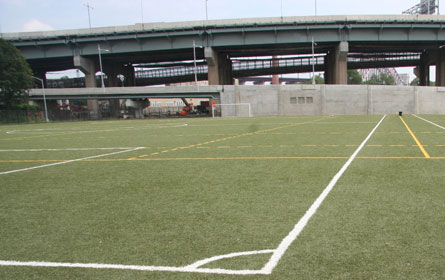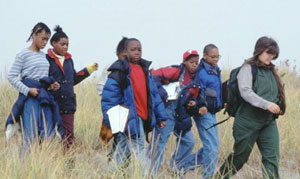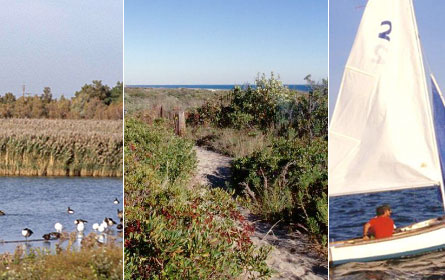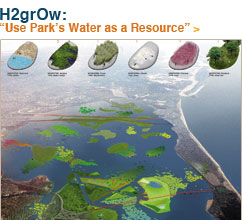Staycationing in the City Parks

On the Sunday of Labor Day weekend, some friends and I went bicycling on Governors Island. We pedaled around and through the small island, along the harbor and past shady lawns and historic buildings. Taking a break at a bright red picnic table at the island's southwestern end, we watched a spectacle starring a massive ocean liner, dozens of smaller craft, the Statue of Liberty and a pod of rapidly crawling swimmers.
We had plenty of company. In some places, the new promenade around the island was so thick with parents and children, tourists and groups of twenty-somethings that we had to stop and walk our bicycles through.
As of Labor Day weekend, more than 180,000 people had come to the island, nearly double the 100,000 who had visited by that time the previous year. To be sure, some of the increase can be attributed to a growing awareness of Governors Island, an increase in ferry service, new amenities like the Water Taxi Beach, and an active schedule of exhibits and events.
But for many city residents like me, it seems that a visit to a park became a mini-vacation in the city, a budget alternative to a weekend in the country or a house at the beach. The New York City parks department does not measure park use, except to estimate beach attendance. But preliminary numbers from some park organizations that do track it showed a dramatic jump this summer in the number of people visiting parks and participating in park activities, despite the second rainiest June and July on record.
The increase in park use indicates that well-maintained and actively programmed public outdoor spaces, so important to city dwellers' quality of life, are even more crucial in a recession. By providing beautiful and interesting destinations for tourists and making a visit to the city more pleasant, parks also give a boost to the city's economy during hard times.
Fresh Spaces
Luckily for New Yorkers, this recessionary summer coincided with the availability of new and newly discovered public spaces, including the High Line, Governors Island and the instant transformation of Broadway at Times and Herald squares into open space with the alchemy of paint, planters and movable tables and chairs. (A notable exception to this trend was in the South Bronx, where Yankee Stadium sits atop a former community park and running track, while residents waiting for the replacement parks got an interim synthetic-turf rooftop track and soccer field whose temperature measured 150 degrees during the August heat wave.)
People also flocked to free events and programs in parks all around the city, from concerts in Springfield Park in Queens to teen art classes in the parks at Battery Park City to the parks department's Learn to Swim programat three dozen pools citywide, which had a 25 percent increase in enrollment.
The free sports, arts and education programs run by the City Parks Foundation in underserved neighborhoods had a significant increase in the number of participants, said Nora Lanning, director of marketing and communication.
The number of children involved in the track program, offered in 37 parks, had grown steadily by about 5 to 7 percent a year over the previous three years, she said, but this summer, the program saw a 27 percent jump in participants. Anticipating the increase, the foundation added afternoon sessions to meet the demand. The year-end track meet, held at Icahn Stadium on Randalls Island, usually brings in 1,200 kids, but had 2,000 this year, said Lanning.
The foundation's free concert program had a 17 percent increase in attendance, attracting not just neighborhood residents but also young people from all over the city, she said, attributing much of the increase to the recession: "When concert tickets are $60, people are willing to travel 50 minutes or an hour to see the same artists for free."
Park by Park
Although the Brooklyn Bridge Park Conservancy offered more free nature education programs, such as seining for marine life in the East River and bird watching, than in the past, classes at the waterfront park filled quickly, and waiting lists had to be established. "We easily could have offered twice as many programs for families and children than we were able to," said acting executive director Nancy Webster.
The Battery Park City Parks Conservancy noted a 20 percent increase in participation in its many activities for adults, families and children, including drawing, tai chi and fishing, according to Battery Park City Authority spokeswoman Leticia Remauro.
Bryant Park takes a daily count of visitors, but the full tab won't be available for several months, said park spokesman Joe Carella. Anecdotal evidence indicates more people coming to the carousel, Monday night movies and other events, but the only numbers available so far are for the outdoor library called the Reading Room, he said. With 53,000 visitors so far, up from just over 38,000 last year, it appears to be heading for record attendance. "Whether it has anything to do with the current economy is speculative," he said, "but one thing we know is that use has been increasing."
Prospect Park has also seen a rise in visitors, Prospect Park Alliance spokesman Eugene Patron wrote in an email, though it is difficult to quantify because it has so many entrances. But the Lefferts Historic House and the Prospect Park Audubon Center does count visitors and saw a significant rise, he said. In June and July '09, for example, 18,184 people visited the Audubon Center, compared with 13,334 the year before; at the Lefferts house, visits increased from 7,387 to 10,608 during the same period.
The trend was visible nationwide as well. A poll conducted in July for The Trust for Public Land found that one fifth of American park users have increased their visits to local parks and playgrounds during the recession and a third of families with children have upped their park use.
"The poll results indicate both a strong, consistent use of local parks and playgrounds and a renewed recognition of their value in tight economic times," said Peter Harnik, director of the Center for City Park Excellence at The Trust for Public Land. "This poll underscores the importance of maintaining and enhancing parks and playgrounds in cities, even during tough times."
Anne Schwartz, in charge of the parks topic page since its inception in 1999, is a journalist who specializes in environmental issues.
When first published, this story said the Bryant Park carousel was free. It actually costs $2.
A Public-slash-Private Park

When State Supreme Court Judge Shirley Kornreich annulled a concession agreement between the Randall's Island Sports Foundation, the Department of Parks and Recreation and a consortium of 20 private schools last winter, Geoffrey Croft, one of the plaintiffs, was pleased.
Gotham Gazette on the Waterfront

.........................
Neglected National Parkland
Our parks columnist explores the national parkland along the New York Harbor -- an area most New Yorkers have never heard of.
.........................
After three tries, a new Mass Transit Tunnel linking New Jersey and New York has broken ground. But advocates question whether this proposal will really ease traffic under the Hudson.
.........................
As planners and developers eye the water's edge, are grassroots and community advocates losing their say?
.........................
"We felt good about it," Croft, the president of the watchdog group NYC Parks Advocates, said. He says he thought the ruling would "make sure that the community is at least informed about the project. We also thought that the construction would stop."
However, construction went on, and in June the city signed off on a new, and some say better, deal. The new deal has reduced the amount of fields reserved for private school use -- a major criticism of the city's first plan -- from two-thirds to half.
But Croft and other critics of the plan, scheduled to go into effect this September, continue to contend that community input from East Harlem and the South Bronx, low-income areas that surround the East River island, has been sorely lacking. Opponents of the concession plan say that none of the members of the sports foundation's board, which runs the island in partnership with the city, live in East Harlem or the South Bronx, and that some members of the board have or had children enrolled in some of the private schools that were part of the concession.
The old accord called for the private schools to pay $2.6 million annually to the Randall's Island Sports Foundation in exchange for the use of two-thirds of the 66 new or improved athletic fields, currently under construction. Under the new agreement, the private schools will pay $2.2 million for the use of 50 percent of the fields. The sports foundation keeps $400,000 from the private school money, and the rest goes to the city.
While the new concession agreement has won over some critics, other community activists continue to voice opposition.
"Children in [East Harlem] and the South Bronx... have [high] asthma rates, there's no quality food supermarkets, so we have the fast food, so we have diabetes and obesity," said Marina Ortiz, a critic of the concession and president and founder of East Harlem Preservation. "People need access to parkland to combat these health issues, and we also have a right. And we're being denied that right, and it's unfair."
A Private Solution
Opponents charge that the Bloomberg administration and the sports foundation are favoring private schools over the surrounding communities, and that the concession amounts to privatizing the island. Critics also say the city has stymied community involvement in the planning process by bypassing the Uniform Land Use Review Procedure.
About 80 percent of the construction on the island is completed, and the remainder should be done by 2011, according to estimates by the Department of Parks and Recreation. While the parks department has slated $61.5 million for the field construction, the total cost of the project skyrockets to $190 million, according to the Independent Budget Office. The Economic Development Corporation has committed $115 million for the project's infrastructure through 2010.
The latest accord has not placated critics. "It's the exact same deal. They've lowered the percentage to 50, [but] they're just trying to do an end-run," around the court order, Croft said.
Ortiz agrees.
"Ramps are being built from various sections of the [RFK Bridge]...to accommodate this commuter park they've designed," she said. "It's not about local access. It's great, everyone should be able to come to Randall's Island, but that means everyone."
At stake is who, when and how much students and community residents get to use the fields on Randall's Island. The island is a vast 273-acre piece of land that sits on the East River and is surrounded by the communities of East Harlem, the South Bronx, and Astoria, Queens. It's sprinkled with facilities from tennis and golf centers, which you have to pay to use, to a homeless shelter, ball fields and more.
The dispute is a classic example of the debate over the proper use of private groups and money that finance public parks. Public-private partnerships, like the one between the sports foundation and the parks department, are seen as one solution to pump money into an underfunded budget for city parks. In the midst of a fiscal crisis, the Bloomberg administration recently slashed $13 million from parks maintenance, making the cuts to parks since 2007 a total of $24 million. However, at the same time, private money has helped to plug holes in the dearth of public money for parks.
"Public-private partnerships that invest in our communities are always appreciated, but especially now, during a fiscal crisis," Phillip Abramson, a spokesman for the parks department, wrote in an e-mail.
The reliance on private money, though, fuels charges of "pay to play" schemes and undue private influence on public and open space.
The City's Position
On the other hand, the city and the sports foundation say the new deal will widen access and create thousands of hours of additional playing time.
Recent testimony given by Richard Davis, the chair of the sports foundation, in front of the Office of Contract Services' Franchise and Concession Review Committee, applauded the deal.
The agreement will give "scores of new first class fields used by all our kids, a greater ability to meet the extensive needs for weekend fields and, for the first time, very meaningful after school use by public school kids," Davis said.
The latest deal has won over some past dissenters, like Manhattan Borough President Scott Stringer, who originally voted against the deal with the private schools.
In an opinion piece for the Spanish-language newspaper El Diario, Stringer wrote, "This new agreement is designed to ensure that the people of the South Bronx and East Harlem have real and meaningful access to all of the Island’s resources."
Stringer also applauded the $100,000 that was secured for 10 sports teams from public schools, and the fact that the teams will be transported with shuttle buses from 125th Street to the island. A spokeswoman for Stringer says that Stringer’s office gave $75,000 for transportation.
The new agreement will create opportunities for healthy activity, "especially for residents of East Harlem and the South Bronx," said Aimee Boden, executive director of the Randall's Island Sports Foundation. The foundation is working "to bring community people out to the park, and to advise them every step of the way," Boden said.
When asked about criticism over the amount of community engagement within the plan for Randall's Island, Boden said the sports foundation has been working with local community boards and residents, and pointed to the existence of a task force on Randall's Island that includes local representatives.
Another Day in Court
A new lawsuit, with many of the same plaintiffs, including Croft and Ortiz, was filed in late May, using largely the same arguments.
The crux of the legal argument against the concession agreement is that the city needs to go through a review process known as the Uniform Land Use Review Procedure because the deal amounted to a "major concession." One of the criteria for determining whether a concession is major is if the concession involves more than 30,000 square feet of open use. The plaintiffs say the parks plan involves more than that. The procedure requires the plan to be submitted first to the community board, and then the borough president, the City Planning Commission and the City Council.
When Kornreich ruled on the original agreement, she wrote, "the court disagrees with this strained interpretation of the concession, an interpretation designed to evade ULURP review."
The city argues that the new concession is not a "major concession" because the new sports fields continue an existing use that existed for the past two years, which is an exception to having to go through the land use procedure. The plan has only gone through the Franchise and Concession Review Committee, where a majority of that committee's members are appointed by the Bloomberg administration, which supports the deal. Mayor Michael Bloomberg is an "honorary trustee" to the board of the Randall's Island Sports Foundation.
The committee has approved the concession agreements, both the annulled one and the newest incarnation.
"Obviously this is another effort at evading [the Uniform Land Use Review Procedure]," said Gavin Kearney, environmental justice director for New York Lawyers for the Public Interest. "Basically, it's the same thing with cosmetic changes, and they're basically trying to avoid the letter and the spirit of the court's ruling," he said.
Also at issue, critics say, is an inadequate environmental review process.
The parks department labeled the ongoing 209-acre construction at Randall's Island a "Type I" action--meaning that actions on the island would have a significant impact on the environment and may require a full environmental review process.
But the department filed a "negative declaration," and argued that construction will not have a big impact on the environmental quality of the island.
Kearney disagrees, and accused the parks department of a "cursory" look at the impact the construction will have.
"We don't think that they have adequately evaluated the impacts and we don't think they have adequately addressed how they're going to mitigate the impacts," he said.
In an e-mail, Abramson of the parks department wrote, "The petitioners' claims are without merit... Based on [our] study, we reasonably concluded that the Randall's Island project has no potential to create adverse impacts."
Kearney remains confident that the plaintiffs will get a favorable ruling.
"I think we're pretty confident that the court will see this for what it is, which is basically another effort to get around the city's legal requirements."
National Parkland Not on Radar

When my 19-year-old daughter and her friends are looking for something to do, they often head for the water. They walk in the park along the Hudson River, go to concerts on a pier, watch movies in Brooklyn Bridge Park or take a ferry to the beach.
Gotham Gazette on the Waterfront

.........................
The city has created a new plan for the ball fields on Randall's Island. Critics, though, are calling foul.
.........................
After three tries, a new Mass Transit Tunnel linking New Jersey and New York has broken ground. But advocates question whether this proposal will really ease traffic under the Hudson.
.........................
As planners and developers eye the water's edge, are grassroots and community advocates losing their say?
.........................
None of this would have been possible twenty or even ten years ago. Over the past two decades, parks have been built and restored around the Manhattan shoreline, along the Bronx River, on the downtown Brooklyn waterfront and on Governors Island, bringing people to the water and redefining the experience of visiting and living in New York City. These changes were illustrated this summer on Governors Island, where expanded ferry service and a new promenade, picnic area, and Water Taxi Beach drew more than 100,000 visitors through July -- nearly twice as much as the entire summer of 2007.
While city and state parks have been the focus of this reinvention of the waterfront, much more can be done to the vast acreage of parks under national jurisdiction. Known together as the National Parks of New York Harbor, these parks offer a tremendous opportunity to integrate the harbor into the life of the city and provide an urban park experience on the level of a Yellowstone or Yosemite.
"There are sites of great renown and beauty, such as the Statue of Liberty, and there are sites that have not come close to realizing their potential and are certainly not the iconic parks that the public deserves," said Alexander Brash, northeast regional director of the National Parks and Conservation Association, a national parks advocacy group.
The Harbor Parks
Few New Yorkers are aware that the National Park Service is the largest single landholder in the harbor, having jurisdiction over 26,000 acres of parkland, wetlands and water, nearly the size of the entire city park system. Most of this acreage is within the three Gateway National Recreation Area units, spanning the Queens, Brooklyn, Staten Island and northern New Jersey shores.
A 2006 poll found that nearly half of New York area residents don't know about and have never visited Gateway. Even so, in 2006, Gateway was the fifth most visited park in the national park system.
New York Harbor is a great estuarine ecosystem and a key stopover on the avian Atlantic Flyway. It has also played a starring role in the history of the country, as the site of the first U.S. government, a great commercial port, a nexus of military defense and the portal for waves of immigration.
The harbor's 10 national parks and monuments, which include 23 unique sites, were grouped together in 2002 as the National Parks of New York Harbor. "Sitting on a boat, or from Governors Island, you can see the sites together and understand America in a different way," said Robert Pirani, the director of environmental programs at the Regional Plan Association.
Among the harbor park sites are Ellis Island, Federal Hall, Castle Williams and Fort Jay on Governors Island, as well as Grant's Tomb and the city's newest national memorial, the African Burial Ground in Manhattan.
The vast acreage of Gateway National Recreation Area includes wetlands, waters, forests and meadows that provide important habitat for birds, fish and shellfish, as well sandy beaches, sports fields, forts, lighthouses and airplane hangars. The 9,000-acre Jamaica Bay National Wildlife Refuge is the largest bird sanctuary in the eastern United States.
Gateway’s Missed Potential
When Congress established Gateway in 1972 as one of the National Park System's first urban national recreation areas (the other being Golden Gate National Recreation Area in San Francisco), it authorized $92 million to restore the collection of shoreline properties that had many different prior uses and were in various states of disrepair. Gateway, though, never got the initial funding -- equivalent to $1.2 billion in today's dollars.
The park's 1979 general management plan envisioned an "opportunity to demonstrate that abused resources can be renewed," and a park offering "millions of Americans a chance to have national park adventures and experiences virtually at their own doorsteps." But the long underfunded national park system was never given the money to restore Gateway's landscapes, renovate many of its structures, build extensive new recreational facilities and provide adequate visitor services.
In addition, public transportation to and within the far-flung sites was never put in place, preventing Gateway from becoming the urban recreational, natural and historical destination it was meant to be. "The whole point of Gateway was to be of service to people living in cities who don't have cars," said Brash.
A 2007 report card by the National Parks and Conservation Association found Gateway's natural and cultural resources in poor condition. Degraded habitat, derelict buildings and impermeable asphalt remain throughout the park. Wetlands and other habitats once teeming with wildlife are damaged by pollution from former landfills, runoff from commercial areas, treated wastewater from city sewage plants and sewage overflows during storms. The wetlands in Jamaica Bay are disappearing at an alarming rate, and the sea level's rise due to global warming will affect the entire park's shoreline.

Floyd Bennett Field, the city's first municipal airport and former a U.S. naval air station, comprises 20 percent of Gateway's land mass, but it has never been renovated to fulfill its potential as the "gateway to Gateway." Runways still cover the landscape. The former control tower and terminal was converted to a visitor center, but much of the interior is crumbling and off-limits to the public. Along with recreation such as bird watching in the grasslands, flying model airplanes and community gardening, the park serves for other city uses, such as training city police and sanitation drivers.
A Harbor Vision
Recent efforts have begun to make Gateway the great urban national park many hoped it would become. Creating a vision and gaining the necessary funding, advocates say, will require the collaboration of agencies at the city, state and federal levels, as well as with the many organizations concerned with the park and harbor.

In 2007, the National Parks and Conservation Association partnered with the Van Alen Institute and Columbia University to hold a design competition, titled Envisioning Gateway. "The idea was not that the winner of the contest would be the one producing the final design for the park, but rather to raise the bar on what the park could and should be," said Brash.
The National Parks Service is working on a new general management plan for Gateway. It has hosted open houses throughout the summer, and there will be five more open houses in September.
Some park advocates are concerned, however, that the process of creating a new plan would recreate the wheel and risk further delay. Advocates the original 1979 management plan to be made available to the public online along with all of the other pertinent information, such as maps, scientific data and documents relating to the development of the new plan.
The original plan should be used as a foundation of the new plan, "so we're not doing zero-based planning," said Dave Lutz, executive director of Friends of Gateway and a participant for several decades in efforts to protect, improve and create access to the recreation area. "Let's look at what's there and decide what we like, what we don't like; what we can do, what we can't do."
Other organizations have focused on the harbor parks as a whole and on improving access and making the harbor a new destination for visitors and residents. The New York Harbor Parks Conservancy was established in 2002 as a nonprofit partner for the city's national parks. Among its goals are to develop waterborne transportation to make the harbor and its islands more accessible and to raise awareness about the historical and cultural significance of the public spaces around the harbor. The conservancy has created several guided harbor tours and is working to increase public access through ferries and buses to the far-flung sites.
New York's congressional delegation has secured some funding for several transit-related projects, including new ferry docks and research for bus-tram service linking Jamaica Bay National Wildlife Refuge and Jacob Riis Park to the subway.
Focusing on the inner harbor, the city's Economic Development Corporation has designated a new harbor district. Next month, as part of NYC 400 week, it is presenting a celebratory Harbor Day, with free bikes and boat service connecting six major waterfront sites.
Restoring and developing Gateway as a model urban national park and a vibrant connection to the waterfront presents a tremendous challenge. It will require a vision that balances ecological conservation, historic preservation and recreation, greatly improved public access, and the cooperation of scores of stakeholders with often conflicting agendas.
 Anne Schwartz, in charge of the parks topic page since its inception in 1999, is a journalist who specializes in environmental issues.
Anne Schwartz, in charge of the parks topic page since its inception in 1999, is a journalist who specializes in environmental issues.




